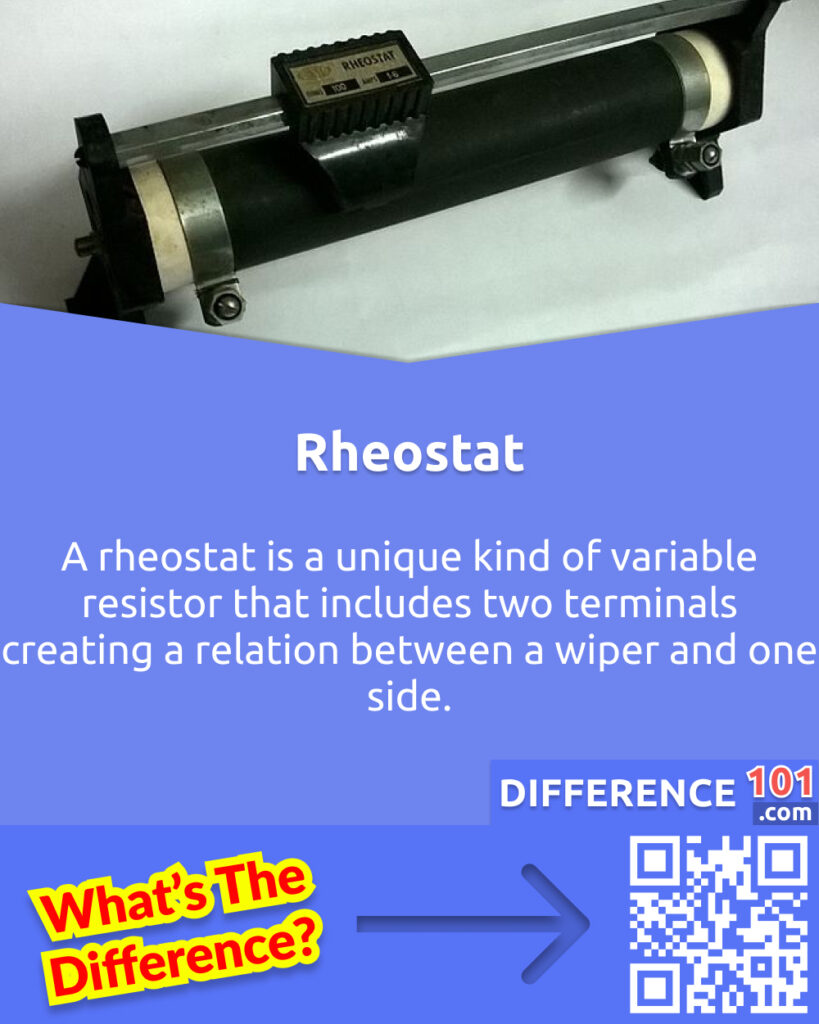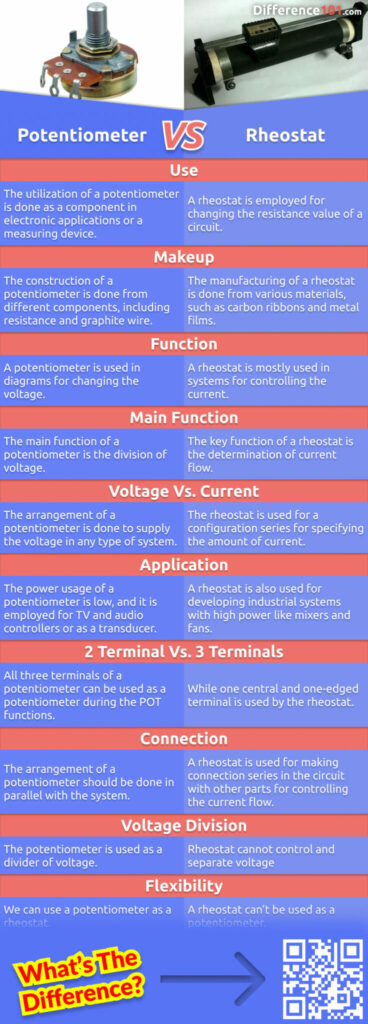Potentiometer vs. Rheostat: you must remember that as a young and fresh college student who kept playing with potentiometers in your initial electronics classes. You must have suddenly started the realization that where all of these components might even get used in everyday devices, and you might not have even been knowing it. Both Potentiometers and rheostats are two different kinds of variable resistors providing a much-simplified way of controlling the voltage drop in the various legs of a system.
Although these components help in the provision of similar basic functions, they are very different and also not always the best replacements for one another. So, what is the thing that helps in making these components different, and why their preference is given in different applications? Here’s when you should be using a potentiometer vs. rheostat and what we should be looking for in the datasheet specs for the selection of the correct component.
Table of Contents
What Is Potentiometer?

A potentiometer is a kind of resistor that includes three terminals with an adjustable divider and sliding contact for voltage regulation.
What Is Rheostat?

A rheostat is a unique kind of variable resistor that includes two terminals creating a relation between a wiper and one side.
Potentiometer And Rheostat Similarities
The construction of potentiometers and rheostats are similar, and they function in very similar ways, like you have the control of voltage and current distribution in a circuit. This looks very simple, but the way how all these components are made makes them good options for various applications.
The Main Difference Between Rheostat And Potentiometer
The most significant difference between a potentiometer and a rheostat is the number of terminals. A potentiometer has three (2 outputs and 1 input) terminals while a rheostat has two (1 input and 1 output) terminals. Thanks to the three terminals of the potentiometer where it can be used as a rheostat when one of its terminals is left for floating. However, the reverse of this is not entirely true. A rheostat can never be used as a potentiometer unless and until you add at least a different resistor to it and create an earthing to the rheostat’s output.
A potentiometer can be considered as a varying voltage divider; as the knob is turned on the device, a sliding contact helps in the creation of a voltage divider between the two outputs and the single input. Hence, the simple use of a potentiometer is for the division of voltage. With a rheostat which is simply a potentiometer having too much resistance at the second output, it manages the total power which is received by the output connected load. If load resistance and rheostat are equal, then most of the power is transferred to the load component.
10 Key Differences Between Rheostat And Potentiometer
| Basis | Potentiometer | Rheostat |
|---|---|---|
| Use | The utilization of a potentiometer is done as a component in electronic applications or a measuring device. | A rheostat is employed for changing the resistance value of a circuit. |
| Makeup | The construction of a potentiometer is done from different components, including resistance and graphite wire. | The manufacturing of a rheostat is done from various materials, such as carbon ribbons and metal films. |
| Function | A potentiometer is used in diagrams for changing the voltage. | A rheostat is mostly used in systems for controlling the current. |
| Main Function | The main function of a potentiometer is the division of voltage. | The key function of a rheostat is the determination of current flow. |
| Voltage vs. Current | The arrangement of a potentiometer is done to supply the voltage in any type of system. | The rheostat is used for a configuration series for specifying the amount of current. |
| Application | The power usage of a potentiometer is low, and it is employed for TV and audio controllers or as a transducer. | A rheostat is also used for developing industrial systems with high power like mixers and fans. |
| 2 Terminal vs. 3 Terminals | All three terminals of a potentiometer can be used as a potentiometer during the POT functions. | While one central and one-edged terminal is used by the rheostat. |
| Connection | The arrangement of a potentiometer should be done in parallel with the system. | A rheostat is used for making connection series in the circuit with other parts for controlling the current flow. |
| Voltage Division | The potentiometer is used as a divider of voltage. | Rheostat cannot control and separate voltage |
| Flexibility | We can use a potentiometer as a rheostat. | A rheostat can’t be used as a potentiometer. |
Selecting a Mechanical Potentiometer or Rheostat
When making the selection of these components, it’s very important to consider that they have some different specifications, even though the configuration of a potentiometer can be done for providing the same functions as a rheostat. Here are some key specifications:
| Maximum Resistance | We should be paying attention to the maximum resistance of the device because it is going to decide the current/voltage limit that will be delivered to the load. Typical values start ranging between 10 Ohms to kilo Ohms. This should be paired very carefully with your current requirements and a power source. |
| Wiper Resistance | The wiper resistance is very important for a rheostat, and it should be very small for providing the exact amount of current for loading. If we are delivering some voltage to some impedance load that is high for a potentiometer, then the wiper resistance should not be very important as this is always too small for the load resistance. In any of these cases, a very careful analysis is needed on how large wiper resistance can be tolerated as the wiper resistance appears in series with the resistance of the load. |
| Taper style | The taper will tell us how the resistance division or the resistance of the device is done across the slide, it varies on a wide scale. Linear taper is useful when control functions are needed, like the linear functions of the current/voltage that is delivered to the load. |
| Power rating | Just like the regular resistors having a power rating, exceeding the power rating of the potentiometers and rheostats can also damage the component. |
Comparison Chart








